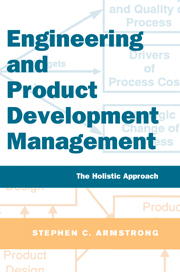Book contents
- Frontmatter
- Contents
- List of figures and tables
- Forewords
- Preface
- Acknowledgments
- Layout of book at a glance
- PART 1 UNDERSTANDING ENGINEERING PROCESS MANAGEMENT
- PART 2 APPLYING ENGINEERING PROCESSES TO PROGRAM MANAGEMENT
- 4 Roles and responsibilities
- 5 Approach to program and project management
- 6 An integrated team member's guide to performing a task
- 7 Program structuring and planning
- 8 Risk assessment
- 9 Program initiation and execution
- 10 Program reviews
- 11 Engineering change management and product data management
- PART 3 DEPLOYING ENGINEERING PROCESS MANAGEMENT
- PART 4 APPENDIXES
- Glossary
- References
- Index
9 - Program initiation and execution
Published online by Cambridge University Press: 05 April 2014
- Frontmatter
- Contents
- List of figures and tables
- Forewords
- Preface
- Acknowledgments
- Layout of book at a glance
- PART 1 UNDERSTANDING ENGINEERING PROCESS MANAGEMENT
- PART 2 APPLYING ENGINEERING PROCESSES TO PROGRAM MANAGEMENT
- 4 Roles and responsibilities
- 5 Approach to program and project management
- 6 An integrated team member's guide to performing a task
- 7 Program structuring and planning
- 8 Risk assessment
- 9 Program initiation and execution
- 10 Program reviews
- 11 Engineering change management and product data management
- PART 3 DEPLOYING ENGINEERING PROCESS MANAGEMENT
- PART 4 APPENDIXES
- Glossary
- References
- Index
Summary
This chapter deals with the important issue of “kicking off” a program. It is critical that a program begins in the right way. Having clear business goals and a professional work environment in place will provide a first-class atmosphere.
PROGRAM INITIATION
The start of a program is critical to its success because it is at this time that the project manager brings together the program team and set up the environment in which it will work. Because the IPTs are the most valuable program resource, ensuring that its members receive the proper training, a clear understanding of the program's goals, and the plans for achieving those goals are closely linked to the final success of the project. Recall from Chapter 8 that during project initiation you can resolve project structuring issues now better than at any other time during the program.
Establish program goals
Program and IPT goals should be established to ensure that the customer's needs are met. The first step in this process is to define the product functions and features, design-to-cost goals, and key milestones. Figure 9-1 illustrates the design-tocost model. Notice how the integration of elements will drive the eventual cost. Investments in process capabilities can be as important to the final cost structure as the design itself. This model helps to establish the mission and focus of the IPTs.
- Type
- Chapter
- Information
- Engineering and Product Development ManagementThe Holistic Approach, pp. 126 - 144Publisher: Cambridge University PressPrint publication year: 2001



